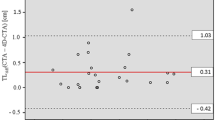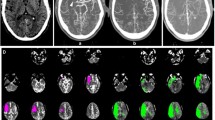Abstract
Objectives
The thrombus length may be overestimated on early arterial computed tomography angiography (CTA) depending on the collateral status. We evaluated the value of a grading system based on the thrombus length discrepancy on dual-phase CT in outcome prediction.
Methods
Forty-eight acute ischemic stroke patients with M1 occlusion were included. Dual-phase CT protocol encompassed non-contrast enhanced CT, CTA with a bolus tracking technique, and delayed contrast enhanced CT (CECT) performed 40s after contrast injection. The thrombus length discrepancy between CTA and CECT was graded by using a three-point scale: G0 = no difference; G1 = no difference in thrombus length, but in attenuation distal to thrombus; G2 = difference in thrombus length. Univariate and multivariate analyses were performed to define independent predictors of poor clinical outcome at 3 months.
Results
The thrombus discrepancy grade showed significant linear relationships with both the collateral status (P = 0.008) and the presence of antegrade flow on DSA (P = 0.010) with good interobserver agreement (κ = 0.868). In a multivariate model, the presence of thrombus length discrepancy (G2) was an independent predictor of poor clinical outcome [odds ratio = 11.474 (1.350–97.547); P =0.025].
Conclusions
The presence of thrombus length discrepancy on dual-phase CT may be a useful predictor of unfavourable clinical outcome in acute M1 occlusion patients.
Key points
• Early arterial phase CTA may underestimate thrombus length.
• Thrombus length discrepancy grade reflects collateral status or presence of antegrade flow.
• Outcome prediction may be better with thrombus length grade than collateral score.

Similar content being viewed by others
Abbreviations
- CECT:
-
Contrast enhanced CT
- NECT:
-
Non-contrast enhanced CT
- DSA:
-
Digital subtraction angiography
- TOAST:
-
Trial of Org 10172 in Acute Stroke Treatment
- mRS:
-
Modified Rankin scale score
- ASPECTS:
-
Alberta Stroke Program Early CT Score
- MIP:
-
Maximum intensity projection
- TICI:
-
Thrombolysis in cerebral infarction
- NIHSS:
-
National Institutes of Health stroke scale
- tPA:
-
Tissue plasminogen activator
References
Lima FO, Furie KL, Silva GS et al (2010) The pattern of leptomeningeal collaterals on CT angiography is a strong predictor of long-term functional outcome in stroke patients with large vessel intracranial occlusion. Stroke 41:2316–2322
Maas MB, Lev MH, Ay H et al (2009) Collateral vessels on CT angiography predict outcome in acute ischemic stroke. Stroke 40:3001–3005
Mokin M, Morr S, Natarajan SK et al (2014) Thrombus density predicts successful recanalization with Solitaire stent retriever thrombectomy in acute ischemic stroke. J Neurointerv Surg. doi:10.1136/neurintsurg-2013-011017
Saarinen JT, Rusanen H, Sillanpaa N (2014) Collateral score complements clot location in predicting the outcome of intravenous thrombolysis. AJNR Am J Neuroradiol 35:1892–1896
Frolich AM, Schrader D, Klotz E et al (2013) 4D CT angiography more closely defines intracranial thrombus burden than single-phase CT angiography. AJNR Am J Neuroradiol 34:1908–1913
Mishra SM, Dykeman J, Sajobi TT et al (2014) Early Reperfusion Rates with IV tPA Are Determined by CTA Clot Characteristics. AJNR Am J Neuroradiol 35:2265–2272
Tan IY, Demchuk AM, Hopyan J et al (2009) CT angiography clot burden score and collateral score: correlation with clinical and radiologic outcomes in acute middle cerebral artery infarct. AJNR Am J Neuroradiol 30:525–531
Yeo LL, Paliwal P, Teoh HL et al (2014) Assessment of intracranial collaterals on CT angiography in anterior circulation acute ischemic stroke. AJNR Am J Neuroradiol. doi:10.3174/ajnr.A4117
Yoo AJ, Hu R, Hakimelahi R et al (2012) CT angiography source images acquired with a fast-acquisition protocol overestimate infarct core on diffusion weighted images in acute ischemic stroke. J Neuroimaging 22:329–335
Choi JY, Kim EJ, Hong JM et al (2011) Conventional enhancement CT: a valuable tool for evaluating pial collateral flow in acute ischemic stroke. Cerebrovasc Dis 31:346–352
Frolich AM, Wolff SL, Psychogios MN et al (2014) Time-resolved assessment of collateral flow using 4D CT angiography in large-vessel occlusion stroke. Eur Radiol 24:390–396
Mortimer AM, Little DH, Minhas KS, Walton ER, Renowden SA, Bradley MD (2014) Thrombus length estimation in acute ischemic stroke: a potential role for delayed contrast enhanced CT. J Neurointerv Surg 6:244–248
Pulli B, Schaefer PW, Hakimelahi R et al (2012) Acute ischemic stroke: infarct core estimation on CT angiography source images depends on CT angiography protocol. Radiology 262:593–604
Calleja AI, Cortijo E, Garcia-Bermejo P et al (2013) Collateral circulation on perfusion-computed tomography-source images predicts the response to stroke intravenous thrombolysis. Eur J Neurol 20:795–802
Jung SL, Lee YJ, Ahn KJ et al (2011) Assessment of collateral flow with multi-phasic CT: correlation with diffusion weighted MRI in MCA occlusion. J Neuroimaging 21:225–228
Lee KH, Cho SJ, Byun HS et al (2000) Triphasic perfusion computed tomography in acute middle cerebral artery stroke: a correlation with angiographic findings. Arch Neurol 57:990–999
Shin NY, Kim KE, Park M et al (2014) Dual-phase CT collateral score: a predictor of clinical outcome in patients with acute ischemic stroke. PLoS One 9, e107379
Menon BK, d'Esterre CD, Qazi EM et al (2015) Multiphase CT angiography: a New tool for the imaging triage of patients with acute ischemic stroke. Radiology 275:510–520
Kloska SP, Dittrich R, Fischer T et al (2007) Perfusion CT in acute stroke: prediction of vessel recanalization and clinical outcome in intravenous thrombolytic therapy. Eur Radiol 17:2491–2498
Lee BI, Nam HS, Heo JH, Kim DI, Yonsei Stroke T (2001) Yonsei Stroke Registry. Analysis of 1,000 patients with acute cerebral infarctions. Cerebrovasc Dis 12:145–151
Adams HP Jr, Bendixen BH, Kappelle LJ et al (1993) Classification of subtype of acute ischemic stroke. Definitions for use in a multicenter clinical trial. TOAST. Trial of Org 10172 in acute stroke treatment. Stroke 24:35–41
Barber PA, Demchuk AM, Zhang J, Buchan AM (2000) Validity and reliability of a quantitative computed tomography score in predicting outcome of hyperacute stroke before thrombolytic therapy. ASPECTS study group. Alberta stroke programme early CT score. Lancet 355:1670–1674
Higashida RT, Furlan AJ, Roberts H et al (2003) Trial design and reporting standards for intra-arterial cerebral thrombolysis for acute ischemic stroke. Stroke 34:e109–e137
Landis JR, Koch GG (1977) The measurement of observer agreement for categorical data. Biometrics 33:159–174
Kim SJ, Noh HJ, Yoon CW et al (2012) Multiphasic perfusion computed tomography as a predictor of collateral flow in acute ischemic stroke: comparison with digital subtraction angiography. Eur Neurol 67:252–255
Berkhemer OA, Fransen PS, Beumer D et al (2015) A randomized trial of intraarterial treatment for acute ischemic stroke. N Engl J Med 372:11–20
Abels B, Villablanca JP, Tomandl BF, Uder M, Lell MM (2012) Acute stroke: a comparison of different CT perfusion algorithms and validation of ischaemic lesions by follow-up imaging. Eur Radiol 22:2559–2567
Frolich AM, Psychogios MN, Klotz E, Schramm R, Knauth M, Schramm P (2012) Antegrade flow across incomplete vessel occlusions can be distinguished from retrograde collateral flow using 4-dimensional computed tomographic angiography. Stroke 43:2974–2979
Nambiar V, Sohn SI, Almekhlafi MA et al (2014) CTA collateral status and response to recanalization in patients with acute ischemic stroke. AJNR Am J Neuroradiol 35:884–890
Sacks D, Black CM, Cognard C et al (2013) Multisociety consensus quality improvement guidelines for intraarterial catheter-directed treatment of acute ischemic stroke, from the American Society of Neuroradiology, Canadian Interventional Radiology Association, Cardiovascular and Interventional Radiological Society of Europe, Society for Cardiovascular Angiography and Interventions, Society of Interventional Radiology, Society of NeuroInterventional Surgery, European Society of Minimally Invasive Neurological Therapy, and Society of Vascular and Interventional Neurology. Catheter Cardiovasc Interv 82:E52–E68
Souza LC, Yoo AJ, Chaudhry ZA et al (2012) Malignant CTA collateral profile is highly specific for large admission DWI infarct core and poor outcome in acute stroke. AJNR Am J Neuroradiol 33:1331–1336
Acknowledgments
The scientific guarantor of this publication is Seung-Koo Lee. The authors of this manuscript declare no relationships with any companies whose products or services may be related to the subject matter of the article. The authors state that this work has not received any funding. No complex statistical methods were necessary for this paper. Institutional review board approval was obtained. The institutional review board of Yonsei University Health System approved this study and granted a waiver of consent. Some study subjects (n = 34/48) have been previously reported in ‘Dual-phase CT collateral score: a predictor of clinical outcome in patients with acute ischemic stroke. PLoS One 9:e107379’. However, an additional 14 patients were included for this study and the primary aim of the two studies are different. Methodology: retrospective, diagnostic or prognostic study, performed at one institution.
Author information
Authors and Affiliations
Corresponding author
Electronic supplementary material
Below is the link to the electronic supplementary material.
ESM 1
(DOCX 17 kb)
Rights and permissions
About this article
Cite this article
Park, M., Kim, Ke., Shin, NY. et al. Thrombus length discrepancy on dual-phase CT can predict clinical outcome in acute ischemic stroke. Eur Radiol 26, 2215–2222 (2016). https://doi.org/10.1007/s00330-015-4018-3
Received:
Revised:
Accepted:
Published:
Issue Date:
DOI: https://doi.org/10.1007/s00330-015-4018-3




